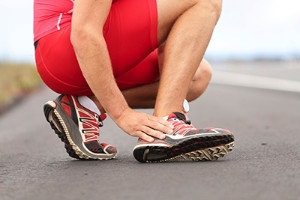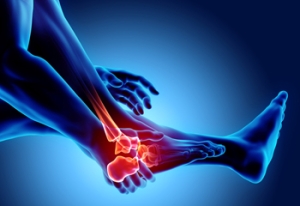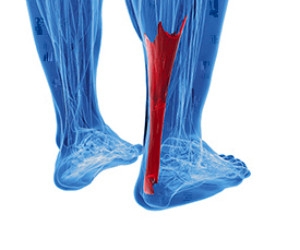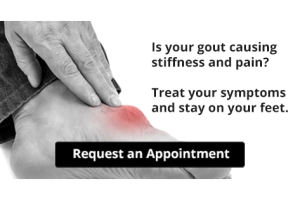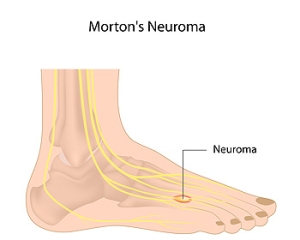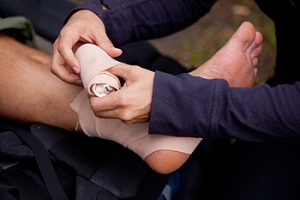Connect With Us

Causes and Symptoms of Cuboid Syndrome
 The cuboid bone is located on the outer side of your foot with a joint and ligaments nearby. These ligaments can tear or become otherwise damaged due to either an ankle sprain or other injury, or from the repetitive strain of certain sports and other activities. These conditions are known as cuboid syndrome, or cuboid subluxation. Cuboid syndrome can also develop in people with flat feet, or when a bone within the joint becomes slightly dislocated. Symptoms of cuboid syndrome usually present themselves on the lateral side of your foot where the ligaments are located, and can include swelling, tenderness, and redness. Additionally, you may experience diminishment in mobility of your ankle and even weakness in the toes nearest to the damaged ligament. While conditions such as arthritis and osteoporosis make you more prone to develop cuboid syndrome, you can reduce your risk by maintaining a healthy body weight, stretching before exercise, and wearing shoes that fit and offer adequate support. If you believe you are experiencing cuboid syndrome or have any pain in your foot, make an appointment with a podiatrist right away for proper diagnosis and treatment.
The cuboid bone is located on the outer side of your foot with a joint and ligaments nearby. These ligaments can tear or become otherwise damaged due to either an ankle sprain or other injury, or from the repetitive strain of certain sports and other activities. These conditions are known as cuboid syndrome, or cuboid subluxation. Cuboid syndrome can also develop in people with flat feet, or when a bone within the joint becomes slightly dislocated. Symptoms of cuboid syndrome usually present themselves on the lateral side of your foot where the ligaments are located, and can include swelling, tenderness, and redness. Additionally, you may experience diminishment in mobility of your ankle and even weakness in the toes nearest to the damaged ligament. While conditions such as arthritis and osteoporosis make you more prone to develop cuboid syndrome, you can reduce your risk by maintaining a healthy body weight, stretching before exercise, and wearing shoes that fit and offer adequate support. If you believe you are experiencing cuboid syndrome or have any pain in your foot, make an appointment with a podiatrist right away for proper diagnosis and treatment.
Cuboid syndrome, also known as cuboid subluxation, occurs when the joints and ligaments near the cuboid bone in the foot become torn. If you have cuboid syndrome, consult with Michael Tomey, DPM from Cary Foot & Ankle Specialists. Our doctor will assess your condition and provide you with quality foot and ankle treatment.
Cuboid syndrome is a common cause of lateral foot pain, which is pain on the outside of the foot. The condition may happen suddenly due to an ankle sprain, or it may develop slowly overtime from repetitive tension through the bone and surrounding structures.
Causes
The most common causes of cuboid syndrome include:
- Injury – The most common cause of this ailment is an ankle sprain.
- Repetitive Strain – Tension placed through the peroneus longus muscle from repetitive activities such as jumping and running may cause excessive traction on the bone causing it to sublux.
- Altered Foot Biomechanics – Most people suffering from cuboid subluxation have flat feet.
Symptoms
A common symptom of cuboid syndrome is pain along the outside of the foot which can be felt in the ankle and toes. This pain may create walking difficulties and may cause those with the condition to walk with a limp.
Diagnosis
Diagnosis of cuboid syndrome is often difficult, and it is often misdiagnosed. X-rays, MRIs and CT scans often fail to properly show the cuboid subluxation. Although there isn’t a specific test used to diagnose cuboid syndrome, your podiatrist will usually check if pain is felt while pressing firmly on the cuboid bone of your foot.
Treatment
Just as the range of causes varies widely, so do treatments. Some more common treatments are ice therapy, rest, exercise, taping, and orthotics.
If you have any questions, please feel free to contact our office located in Cary, NC . We offer the newest diagnostic and treatment technologies for all your foot care needs.
Cuboid Syndrome
Cuboid syndrome mostly affects athletes, although it can affect non-athletes too. It is also known as cuboid subluxation or cuboid fault syndrome. This condition occurs when joints and ligaments near the cuboid bone of the foot are damaged, or when the cuboid bone itself is dislodged from its natural position. It is usually marked by pain on the outer side of the foot, which may be persistent or may come and go. Cuboid syndrome can be difficult to diagnose unless it becomes severe and more noticeable. Your doctor will likely ask questions about when the pain began and how long it has been present, and will put pressure on the cuboid bone to determine if that area is the origin of the pain.
Causes of Cuboid Syndrome
- Any repetitive stresses placed on the foot due to athletic activities are a common cause of cuboid syndrome.
- Although it develops over time, it is possible that this syndrome can occur all of sudden due to a single event or injury.
- Over-pronation can exacerbate the condition if not corrected.
Disagreements Amongst Podiatrists Regarding Cuboid Syndrome
- Some refer to it as the dislocation of the calcaneal-cuboid joint only.
- Other podiatrists see it as an injury of the ligaments located nearby, which also involves the cuboid bone.
It is very important that when you experience any kind of pain on the side of your foot, you should seek medical care right away. If a subluxed cuboid is caught early, your feet may respond well to the treatment, and you can get back into sports or other activities again as soon as the pain subsides.
What Is Juvenile Idiopathic Arthritis?
Juvenile idiopathic arthritis (JIA) is the most common type of arthritis in children and adolescents. This condition can cause inflammation and joint pain in any joint in the body, including those in the feet and ankles. These symptoms can make it difficult to walk, as joints become stiff, swollen, and tender. The child may become easily tired, and it can become harder to complete activities of daily living. JIA is an autoimmune disease and its causes are currently unknown. If your child has JIA that affects their feet or ankles, a podiatrist can help manage the foot and ankle symptoms associated with this disease.
Arthritis can be a difficult condition to live with. If you are seeking treatment, contact Michael Tomey, DPM from Cary Foot & Ankle Specialists. Our doctor can provide the care you need to keep you pain-free and on your feet.
Arthritic Foot Care
Arthritis is a joint disorder that involves the inflammation of different joints in your body, such as those in your feet. Arthritis is often caused by a degenerative joint disease and causes mild to severe pain in all affected areas. In addition to this, swelling and stiffness in the affected joints can also be a common symptom of arthritis.
In many cases, wearing ill-fitting shoes can worsen the effects and pain of arthritis. Wearing shoes that have a lower heel and extra room can help your feet feel more comfortable. In cases of rheumatoid arthritis, the arch in your foot may become problematic. Buying shoes with proper arch support that contour to your feet can help immensely.
Alleviating Arthritic Pain
- Exercises that stretch the foot can prevent further pain and injury and increase mobility
- Most of the pain can be alleviated with anti-inflammatory drugs, heat, and topical medications
- Massages can help temporarily alleviate pain.
It is best to see your doctor for the treatment that is right for your needs and symptoms. Conditions vary, and a podiatrist can help you determine the right method of care for your feet.
If you have any questions, please feel free to contact our office located in Cary, NC . We offer the newest diagnostic tools and technology to treat your foot and ankle needs.
Arthritic Foot Care
During your lifetime, you will probably walk about 75,000 miles, which is quite a lot of stress to put on your feet. As you get older, the 26 bones and 30 joints in each of your feet will lose flexibility and elasticity. Your foot’s natural shock absorbers will wear down as well. Having arthritis added to this mix only makes matters worse. Your joints will become distorted and inflamed, which is why arthritic foot care needs to be something to think about every day.
When dealing with arthritis, having additional foot complications, such as bunions, hammertoes, or neuroma, can be a serious detriment. To avoid these, buy well-fitting shoes with a lower heel and good support. Arthritis causes you to lose your arch, so having shoes with good arch support is also highly recommended.
Aside from getting good arch support, the shoes need to fit comfortably and properly as well. A good place to start is by leaving a finger width between the back of the shoe and your foot to gauge proper size. It is also helpful to have a square or rounded toe box in the front to provide even more comfort. Another thing to look for is a rubber sole that can provide a cushion and absorb shock as you walk. This adds flexibility to the ball of your foot when you push off your heel to walk.
Exercise is another key aspect of arthritic foot care. Exercise not only strengthens and stretches your muscles and joints, but helps to prevent further injury and pain as well. Stretching the Achilles tendon, the tendon located in the back of your heel, will give you added mobility and reduce pain due to stress. Another thing you can do is massage your feet, kneading the ball of your foot as well as your toes from top to bottom.
Stretching the Achilles tendon is a simple exercise that you can do at home anytime. Lean against the wall with your palms flat against the surface while placing one foot forward, towards the wall, and one foot behind you. Bend your forward knee towards the wall while keeping your back knee locked straight, and make sure both your heels are completely touching the ground at all times. This will stretch your Achilles tendon and calf muscles as well. You will feel the stretch almost immediately. You can also stretch your toes in a couple ways. One involves taking a rubber band and wrapping it around both your big toes while your heels remain together. Then, pull them apart to stretch your big toe. You can also place a rubber band around all the toes of one of your feet. Then, try to separate each individual toe, stretching them all.
A final step you can take to help your arthritis is taking non-steroid, non-inflammatory drugs or topical medicines with capsaicin. Unfortunately, there is no complete way to remove all of your arthritic pain. However, following some of this advice can go a long way in staying as pain-free as possible.
Types of Achilles Tendon Injuries
 The Achilles tendon is a thick band connecting the calf muscle to the heel bone on the back of the ankle. One common injury, Achilles tendonitis, is the result of the tendon becoming inflamed near its connection to the heel bone. This injury is often a result of overuse. Achilles tendinosis occurs when the tendon degenerates, often as a result of not treating Achilles tendonitis. One of the most severe Achilles tendon injuries is a rupture. This occurs when the fibers in the tendon are partially or completely torn. This requires immediate medical attention. Most Achilles tendon injuries result in pain in the calf and heel while moving, and a rupture will produce a sudden sharp pain in the calf and heel. If you are noticing pain or stiffness in the area of your Achilles tendon, please consult with a podiatrist as soon as possible.
The Achilles tendon is a thick band connecting the calf muscle to the heel bone on the back of the ankle. One common injury, Achilles tendonitis, is the result of the tendon becoming inflamed near its connection to the heel bone. This injury is often a result of overuse. Achilles tendinosis occurs when the tendon degenerates, often as a result of not treating Achilles tendonitis. One of the most severe Achilles tendon injuries is a rupture. This occurs when the fibers in the tendon are partially or completely torn. This requires immediate medical attention. Most Achilles tendon injuries result in pain in the calf and heel while moving, and a rupture will produce a sudden sharp pain in the calf and heel. If you are noticing pain or stiffness in the area of your Achilles tendon, please consult with a podiatrist as soon as possible.
Achilles tendon injuries need immediate attention to avoid future complications. If you have any concerns, contact Michael Tomey, DPM of Cary Foot & Ankle Specialists. Our doctor can provide the care you need to keep you pain-free and on your feet.
What Is the Achilles Tendon?
The Achilles tendon is a tendon that connects the lower leg muscles and calf to the heel of the foot. It is the strongest tendon in the human body and is essential for making movement possible. Because this tendon is such an integral part of the body, any injuries to it can create immense difficulties and should immediately be presented to a doctor.
What Are the Symptoms of an Achilles Tendon Injury?
There are various types of injuries that can affect the Achilles tendon. The two most common injuries are Achilles tendinitis and ruptures of the tendon.
Achilles Tendinitis Symptoms
- Inflammation
- Dull to severe pain
- Increased blood flow to the tendon
- Thickening of the tendon
Rupture Symptoms
- Extreme pain and swelling in the foot
- Total immobility
Treatment and Prevention
Achilles tendon injuries are diagnosed by a thorough physical evaluation, which can include an MRI. Treatment involves rest, physical therapy, and in some cases, surgery. However, various preventative measures can be taken to avoid these injuries, such as:
- Thorough stretching of the tendon before and after exercise
- Strengthening exercises like calf raises, squats, leg curls, leg extensions, leg raises, lunges, and leg presses
If you have any questions please feel free to contact our office located in Cary, NC . We offer the newest diagnostic tools and technology to treat your foot and ankle needs.
Achilles Tendon Injuries
The Achilles tendon is the largest tendon in the body; it is a tough band of fibrous tissue that stretches from the bones of the heel to the calf muscles. This tendon is what allows us to stand on our toes while running, walking, or jumping, it is common for this tendon to become injured. In severe cases, the Achilles tendon may become partially torn or completely ruptured. However, this tendon is susceptible to injury because of its limited blood supply and the high level of tension it endures.
The people who are more likely to suffer from Achilles tendon injuries are athletes who partake in activities that require them to speed up, slow down, or pivot. Consequently, athletes who engage in running, gymnastics, dance, football, baseball, basketball, or tennis are more likely to suffer from Achilles tendon injuries. Additionally, there are other factors that may make you more prone to this injury. People who wear high heels, have flat feet, tight leg muscles or tendons, or take medicines called glucocorticoids are more likely to have Achilles tendon injuries.
A common symptom of an Achilles tendon injury is pain above the heel that is felt when you stand on your toes. However, if the tendon is ruptured, the pain will be severe, and the area may become swollen and stiff. Other symptoms may be reduced strength in the lower ankle or leg area, and reduced range of motion in the ankle. When the Achilles tendon tears, there is usually a popping sound that occurs along with it. People who have acute tears or ruptures may find walking and standing to be difficult.
If you suspect you have injured your Achilles tendon, you should see your podiatrist to have a physical examination. Your podiatrist will likely conduct a series of tests to diagnose your injury including a “calf-squeeze” test. Calf squeeze tests are performed by first squeezing the calf muscle on the healthy leg. This will pull on the tendon and consequently cause the foot to move. Afterward, the same test will be performed on the injured leg. If the tendon is torn, the foot won’t move because the calf muscle won’t be connected to the foot.
Factors That Cause Morton’s Neuromas
 The pain and discomfort from a Morton’s neuroma is typically felt between the third and fourth toes. It occurs as a result of an inflamed nerve that is located in this part of the foot. It can be accompanied by a burning sensation or a feeling that there is a lump inside the foot. A Morton's neuroma can happen as a result of wearing shoes that do not have adequate room for the toes to move freely in or from consistently wearing high heels. A proper diagnosis includes having a physical exam performed and may be followed by an imaging study such as an MRI. If you are experiencing pain in this part of your foot, it is recommended that you schedule a consultation with a podiatrist who can effectively treat Morton’s neuroma.
The pain and discomfort from a Morton’s neuroma is typically felt between the third and fourth toes. It occurs as a result of an inflamed nerve that is located in this part of the foot. It can be accompanied by a burning sensation or a feeling that there is a lump inside the foot. A Morton's neuroma can happen as a result of wearing shoes that do not have adequate room for the toes to move freely in or from consistently wearing high heels. A proper diagnosis includes having a physical exam performed and may be followed by an imaging study such as an MRI. If you are experiencing pain in this part of your foot, it is recommended that you schedule a consultation with a podiatrist who can effectively treat Morton’s neuroma.
Morton’s neuroma is a very uncomfortable condition to live with. If you think you have Morton’s neuroma, contact Michael Tomey, DPM of Cary Foot & Ankle Specialists. Our doctor will attend to all of your foot care needs and answer any of your related questions.
Morton’s Neuroma
Morton's neuroma is a painful foot condition that commonly affects the areas between the second and third or third and fourth toe, although other areas of the foot are also susceptible. Morton’s neuroma is caused by an inflamed nerve in the foot that is being squeezed and aggravated by surrounding bones.
What Increases the Chances of Having Morton’s Neuroma?
- Ill-fitting high heels or shoes that add pressure to the toe or foot
- Jogging, running or any sport that involves constant impact to the foot
- Flat feet, bunions, and any other foot deformities
Morton’s neuroma is a very treatable condition. Orthotics and shoe inserts can often be used to alleviate the pain on the forefront of the feet. In more severe cases, corticosteroids can also be prescribed. In order to figure out the best treatment for your neuroma, it’s recommended to seek the care of a podiatrist who can diagnose your condition and provide different treatment options.
If you have any questions, please feel free to contact our office located in Cary, NC . We offer the newest diagnostic and treatment technologies for all your foot care needs.
Morton's Neuroma
A neuroma is a thickening of nerve tissue and can develop throughout the body. In the foot, the most common neuroma is a Morton’s neuroma; this typically forms between the third and fourth toes. The thickening of the nerve is typically caused by compression and irritation of the nerve; this thickening can in turn cause enlargement and, in some cases, nerve damage.
Neuromas can be caused by anything that causes compression or irritation of the nerve. A common cause is wearing shoes with tapered toe boxes or high heels that force the toes into the toe boxes. Physical activities that involve repeated pressure to the foot, such as running or basketball, can also create neuromas. Those with foot deformities, such as bunions, hammertoes, or flatfeet, are more likely to develop the condition.
Symptoms of Morton’s neuroma include tingling, burning, numbness, pain, and the feeling that either something is inside the ball of the foot or that something in one’s shoe or sock is bunched up. Symptoms typically begin gradually and can even go away temporarily by removing one’s shoes or massaging the foot. An increase in the intensity of symptoms correlates with the increasing growth of the neuroma.
Treatment for Morton’s neuroma can vary between patients and the severity of the condition. For mild to moderate cases, padding, icing, orthotics, activity modifications, shoe modifications, medications, and injection therapy may be suggested or prescribed. Patients who have not responded successfully to less invasive treatments may require surgery to properly treat their condition. The severity of your condition will determine the procedure performed and the length of recovery afterwards.
Types of Ankle Sprains
 Ankle sprains occur when the ligaments that connect the bones in the ankle become stretched or torn. Ankle sprains are divided into 3 categories. A Grade 1 sprain occurs when the ligament is mildly stretched. Once a ligament is slightly torn, a Grade 2 sprain occurs. A Grade 3 ankle sprain is the complete tear of one of the ligaments in the ankle. Sprains are usually indicated by pain, tenderness, bruising, stiffness, and an inability to put weight on the affected ankle. Upon experiencing a possible ankle sprain, it is important to visit with a podiatrist. A podiatrist will take X-rays to make sure there isn’t a fracture, and they will also determine the severity of the sprain. After the injury is assessed, your podiatrist will suggest the proper treatment options.
Ankle sprains occur when the ligaments that connect the bones in the ankle become stretched or torn. Ankle sprains are divided into 3 categories. A Grade 1 sprain occurs when the ligament is mildly stretched. Once a ligament is slightly torn, a Grade 2 sprain occurs. A Grade 3 ankle sprain is the complete tear of one of the ligaments in the ankle. Sprains are usually indicated by pain, tenderness, bruising, stiffness, and an inability to put weight on the affected ankle. Upon experiencing a possible ankle sprain, it is important to visit with a podiatrist. A podiatrist will take X-rays to make sure there isn’t a fracture, and they will also determine the severity of the sprain. After the injury is assessed, your podiatrist will suggest the proper treatment options.
Although ankle sprains are common, they aren’t always minor injuries. If you need your ankle injury looked at, contact Michael Tomey, DPM from Cary Foot & Ankle Specialists. Our doctor can provide the care you need to keep you pain-free and on your feet.
How Does an Ankle Sprain Occur?
Ankle sprains are the result of a tear in the ligaments within the ankle. These injuries may happen when you make a rapid shifting movement while your foot is planted. A less common way to sprain your ankle is when your ankle rolls inward while your foot turns outward.
What Are the Symptoms?
- Pain at the sight of the tear
- Bruising/Swelling
- Ankle area is tender to touch
- In severe cases, may hear/feel something tear
- Skin discoloration
Preventing a Sprain
- Wearing appropriate shoes for the occasion
- Stretching before exercises and sports
- Knowing your limits
Treatment of a Sprain
In many cases, the RICE method (Rest, Ice, Compression, and Elevate) is used to treat ankle sprains. However, you should see a podiatrist to see which treatment option would work best with your injury. In severe cases, surgery may be required.
It is important to ask your doctor about rehab options after you receive treatment for your injury. Stretching, strength training, and balance exercises may help the ankle heal while also preventing further injury.
If you have any questions, please feel free to contact our office located in Cary, NC . We offer the newest diagnostic and treatment technologies for all your foot care needs.
